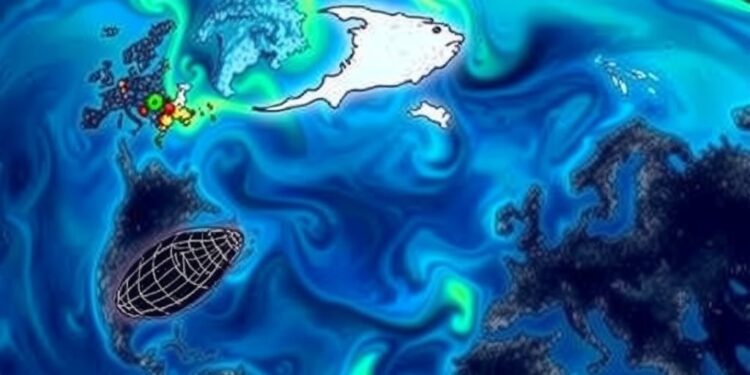A groundbreaking study, recently published in the esteemed journal Nature Communications, has unveiled significant insights into the origin and evolution of the North Atlantic Oscillation (NAO). Conducted by a team of researchers from Peking University, led by Associate Professor Nie Ji from the School of Physics, and Dean Hu Yongyun from the Institute of Ocean Research, the research represents a pivotal advancement in understanding how geological features have influenced atmospheric patterns over geological timescales.
The NAO is a critical phenomenon affecting climate variability, particularly in regions including Europe, China, and North America. By revealing the relationship between NAO and geological developments such as the evolution of continents, oceans, and mountain ranges, the research affords scientists a comprehensive perspective on how these factors shape present-day climate patterns. With climate change concerns looming larger, such insights could not be more timely.
The research team employed an innovative simulation methodology, examining the atmospheric pressure patterns from 160 million years ago to the present day. They meticulously analyzed how alterations in the width of the North Atlantic influenced NAO, offering a temporal context that is essential for understanding its development. By employing idealized experiments, they probed whether a minimum ocean basin width is requisite for NAO’s formation, a question critical to unraveling its mechanism.
One of the key findings of the research delineates the emergence of the NAO, which is suggested to have occurred between 80 and 60 million years ago as the North Atlantic expanded to approximately 40° longitude. The study articulates how this geographic transformation facilitated changes in atmospheric circulation and weather patterns, essentially providing a backdrop for the emergence of NAO. The research indicates that climatic differences between land and sea—specifically, the temperature contrasts—were crucial in shaping the westerly jet streams and storm tracks that are phytogenetically linked to NAO.
In the latter stages of the study, the focus shifted to geological uplift and its implications for NAO. Notably, the Rocky Mountain uplift around 40 million years ago is theorized to have further intensified NAO. This geological event created topographic stationary waves that influenced atmospheric dynamics significantly. By providing a clearer connection between this uplift and alterations in NAO intensity, the study highlights the intricate interplay of tectonic movements and atmospheric circulation.
The implications of understanding NAO’s origins extend beyond mere academic interest; they carry critical importance for improving climate prediction models. Since NAO serves as a linchpin for various climate phenomena, developing better predictive models can empower policymakers and scientists to better react to emergent weather patterns and climate variability. With rising global temperatures and increasingly erratic weather patterns, a comprehensive grasp of these dynamics is essential.
Nevertheless, while the study reveals substantial insights, it also acknowledges areas necessitating further investigation. The researchers highlighted that significantly more work is required to explore the evolution of the leading empirical orthogonal function of extratropical geopotential variation across the Northern Hemisphere. This further research will be paramount in understanding the broader implications of climate influencers and refining the predictions made on future weather patterns.
To advance academic discourse in this area, the study also brings up the involvement of the Tibetan Plateau and its climatic roles, which have yet to be fully disentangled from those of other geographic features such as the Rocky Mountains. This multidimensional approach emphasizes the complexity of climatic phenomena, advocating for comprehensive studies to ensure all contributing factors are appropriately analyzed.
Our planet’s climate system is inherently complex, influenced by myriad geological, atmospheric, and oceanic interactions. As such, research like this presents a crucial scholarly foundation for those aimed at deciphering the intricate tapestry of environmental patterns driving today’s climate crises. The academic community eagerly anticipates further findings as they explore the implications of plate tectonics on atmospheric circulation over geological timescales.
Moreover, public awareness and knowledge around the North Atlantic Oscillation’s influence on climate variability will only serve to deepen as this research permeates broader discussions on climate change. As the interaction between our planet’s physical characteristics and climate becomes clearer, the Peking University research team offers a vital contribution ensuring that discourse on climate forecasting is rooted in solid scientific inquiry.
By bolstering our understanding of the NAO and its geological roots, this research stands as a testament to the importance of interdisciplinary collaborations. The collective efforts between oceanographers, physicists, and climate scientists underscore the need for integrated approaches in tackling one of the most pressing challenges of our time—climate change. Thus, it is through studies like these that a clearer pathway can emerge, guiding both scientific advancement and effective policymaking in climate strategy.
In conclusion, the research illuminates the intricate threads linking geological transformations to climate phenomena. Its findings will undoubtedly enrich the scientific community’s understanding of atmospheric dynamics, aiding in the quest to predict climate variations more accurately. As these complex systems are further unraveled, we can anticipate future discoveries that promise even deeper insights into the relationship between Earth’s physical landscape and its atmospheric responses.
Subject of Research: Origin and evolution of the North Atlantic Oscillation
Article Title: Origin and evolution of the North Atlantic Oscillation
News Publication Date: March 31, 2025
Web References: Nature Communications
References: DOI: 10.1038/s41467-025-57395-4
Image Credits: Not specified.
Keywords
Climate variability, Pattern formation, Oscillations




